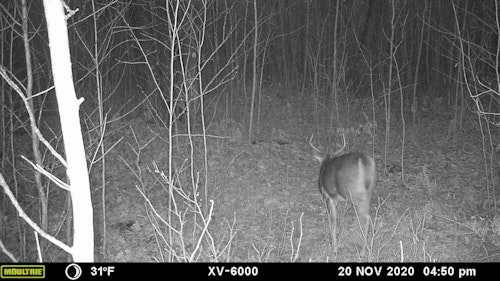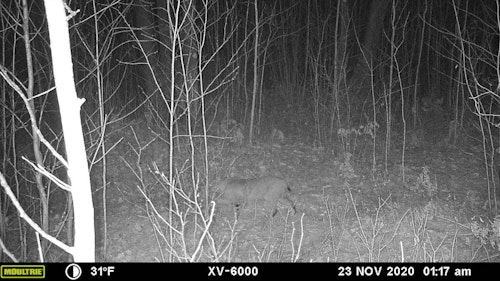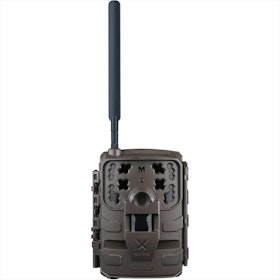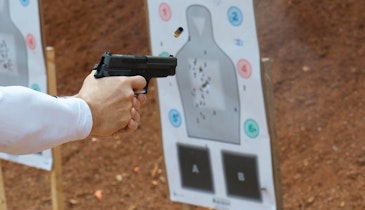I’ve been deer hunting a long time, but I’d never used a trail camera until last year. Turns out I love them, but not necessarily for the reasons you’d expect. And that’s good for your sales potential.
When Moultrie reached out last summer and offered to send one of their new XV-6000 trail cameras, I’ll admit I wasn’t overly excited but figured it would be cool to check out. And since all the photos are sent directly to my phone, it didn’t require much effort other than choosing a spot to put the camera and spending a couple minutes setting it up.
Before heading out into the woods to put the camera in place, I had to install the Moultrie Mobile app on my phone and register and activate the camera. It was a quick and easy process. In this case I had a code from Moultrie for free service, but new users will select their plan at this point.
Dogs, Cats and Deer
I initially placed the camera on a trail near my hunting cabin in late August. The foliage was thick and I made the mistake of setting up in an area that wasn’t quite open enough. Over the first week and a half I ended up with photos of a couple does and several branches bobbing in the wind.
A couple weeks later I moved it to another trail, and then out to an oak ridge where I have a ladder stand and expected to see more deer. I don’t bait, and there are no clear feeding areas in the thick woods I hunt — the whole landscape is covered with browse — so the oak ridge seemed a good bet. Surprisingly, my results didn’t change. I actually didn’t get a photo of a single deer, or any other animal, over the course of two weeks. Disappointing, but good intel nonetheless.
That brings up a valuable point: You can use a camera to get photos of big bucks to target or brag about to your friends, or you can use it as a legitimate tool to gather intelligence about what’s happening in a given area, whether it’s deer movement or determining what’s getting into your chicken coop.
I finally moved the camera to a trail intersection in the middle of a large flat filled with young aspens and scattered oaks on the edge of public land. That’s when things started to get more interesting.
It took two days for the first animal to show up on screen. Unfortunately it was a bird-hunting dog with an orange collar. Late that night, the first deer wandered into frame. Four days later, the first buck came in — a solid 8 that would have drawn fire from anyone in my hunting group.
It was relatively quiet over the next week and a half. The first snowfall blanketed the ground and I got photos of a couple does, a snowshoe hare and, 11 days after the first sighting, another photo of that buck in the same spot at roughly the same time.
Over the next couple weeks a string of bucks came through. Some smaller, but one bigger. They were obviously on the move so I bowhunted a couple nearby stands over the next two weeks. I couldn’t connect with anything I’d seen on camera, but it made those sits more exciting knowing there were nice bucks using the area.
Activity on camera slowed down during the third week in November, but then on Nov. 20, the evening before opening day of Wisconsin’s nine-day gun deer season, another nice buck strolled through. On the 23rd, a bobcat walked through at 1:17 a.m.
Things were quiet for the rest of the gun season. Does came through occasionally, and there were regular appearances from one or more snowshoe hares, but the next buck didn’t show up until Dec. 12, during the December antlerless season.
On Dec. 14, a bobcat came through in the morning. I’d had a pretty close encounter with what I assume was the same cat about a hundred yards away the day before. I watched it chase a hare in front of me and was within 20 feet of the cat at one point.
The bobcat’s appearance coincided with the end of my hunting in the area for the remainder of the season. But I kept the camera out.
Over the next few months I got photos of a lot of deer, a few coyotes, what appeared to be a skunk, countless hares and a fisher.
It was educational. The camera gave me a better idea of what was happening in the area I hunt. Seeing several nice bucks brought some extra enthusiasm to deer camp. And even after the hunting seasons were closed, it kept me connected to those woods when I was nowhere near.
Heart of the System
The 6000-series camera I tested was last year’s model and is no longer available. Moultrie completely sold out of its inventory after Christmas. But not to worry: The company’s new model, the Moultrie Delta, is now available.
The Delta utilizes the same Moultrie Mobile app with all the same features I enjoyed with the XV-6000. It’s easy to tag and rate photos and sort them however you want — no need to scroll through hundreds of photos to find the three images of the buck you named Jim. I request high-res versions of the more interesting photos, and frequently sort with the high-res-only filter.
“The app is really the heart of the Moultrie Mobile system, with AI technology that smart-tags bucks, turkeys, people, vehicles and more automatically,” says Mark Olis, content marketing manager with PRADCO Outdoor Brands.
All the filters, interactive mapping and other features built into the system are free to the user. There’s also free unlimited cloud storage, and Moultrie never deletes a user’s images. That’s not only wallet-friendly, it provides the opportunity to collect more data and build insight over time.
“I’ve been on the Moultrie Mobile system since 2016 and have never deleted images,” Olis says. “I also used the custom tagging feature to tag specific bucks with the name I gave them and I can go back and filter those individual bucks and see their progress through the years.”
Staying Connected
Any camera can capture images. The ability to use those photos and the information they contain to gain a better understanding of wildlife activity and patterns over time is what separates this system. It allows you to build a database of information on your specific piece of woods.
The advantages of a cellular camera are many and varied. For hunters, they eliminate the need to repeatedly trudge into an area you want to hunt to check the memory card and get the photos. For property owners, they can serve as mobile security systems that work anywhere and require no external power source. Olis says they have quite a few customers who use the system purely as a security option to keep an eye on remote properties and other sites.
Regardless of how they’re used, they’re convenient and easy. And the Moultrie-branded AA batteries that came with my camera are still working seven months after I put the camera out.
I think more surprising to me is, seven months later and five months from my next hunting season, I’m still checking the app and looking at new photos regularly.
I jettisoned Facebook a while back, and with the Moultrie Mobile system this little piece of woods near my cabin became my social network. I watched all its inhabitants, kept track of what they were up to and felt like I still had a foot in the woods even when I was sitting at my desk. That should be an easy sell.
Moultrie Delta Cellular Camera
Cost: $99.99
Subscription plans: Starting at $7.99 per month
Image storage: Free unlimited cloud storage, no image purging
Other features: Smart-tags, species recognition, interactive maps, onboard GPS, video transmission, 80-foot detection range, two-year warranty










